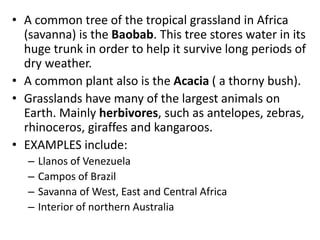- Biomes are large ecosystems defined by climate, plants and animals. The main factors that determine a biome are temperature and rainfall.
- Six main biomes are described: tropical rainforests, tropical grasslands, tropical deserts, temperate grasslands, temperate coniferous forests, and arctic tundra.
- Climate largely determines the types of plants in an area, which then support certain animal life. Temperature and precipitation patterns dictate the distribution of global biomes.



































![• Temperate coniferous forests are also called
Boreal forests and Taiga.
• Coniferous forests adapt to the cold climate.
– They produce their seeds in cones and have leaves
shaped like needles, and have thick barks, example fir,
spruce, pine, larch and hemlock. [Coniferous means
cone-bearing]
– These keep water from evaporating.
– Because of low temperatures, the trees grow slowly
and are much smaller than those of the rainforest, and
there are far fewer species. The trees are also conical
in shape.
• Animals that have thick furs, such as squirrels,
deers, moose, beavers, wolves, brown bears, to
keep warm during colder/winter months.](https://image.slidesharecdn.com/biomes-190502203757/85/Biomes-36-320.jpg)













